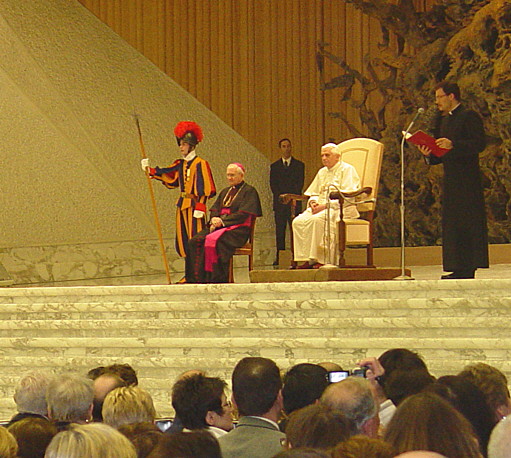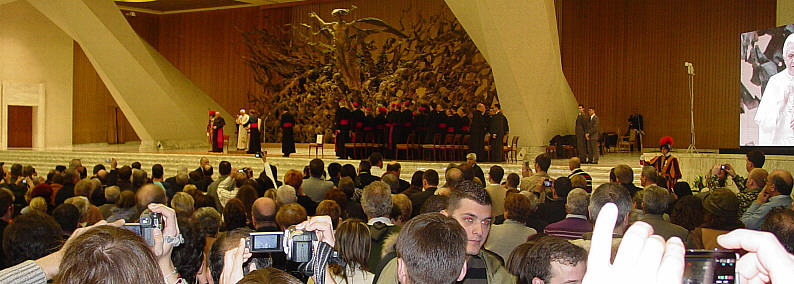Day 4 in Rome - Feb 7 |
Visiting Pope Benedict! |
|
After breakfast we begin our day's activities. We have only three today, all at the Vatican: Visit to Pope, visit the archeological diggings under St. Peter's, and browse the Museum commemorating the 500th anniversary of the beginning of St. Peter's.  The clerics next to the huge bronze sculpture watch the Pope on the monitor. Our first goal: attend Pope Benedict's usual Wednesday Papal general audience. We begin by joining masses of people carrying blue and yellow tickets. Our blue tickets get us into the back two thirds of a huge auditorium, the audience room. Yellow tickets get people in the front third, supposedly better seats. We are an hour or so early. Slowly the room fills. People with blue tickets are continually prevented from entering the front part of the hall. We are a huge crowd. A giant television screen comes to life in the corner of the stage. Doors are shut and open. The guard lets some blue tickets go to the front. We move there. Seats are not much better. The TV screen shows the pope in St. Peter's receiving people there. Music plays. The pope blesses the crowd. Are we only going to watch him on the TV? Are we the over-flow crowd? This is not what I thought it was going to be.  People watch the monitor in the front as the pope comes in the back of the hall, way back there. Not to worry. In a bit the pope comes in the back of the hall and begins to make his way down the center isle shaking hands with everyone as he goes, rather like an American politician looking for votes. After fifteen minutes he makes his way to his chair at stage center. There are readings. And then the pope gives a short sermon in Italian. Various speakers introduce "pilgrim" groups from several lands. The pope gives basically the same sermon to each group in its native language, French, German, Polish, Spanish, English, Italian, Russian, and a couple others I do not remember. In the end there is a papal blessing and all leave. We have had our audience with the pope, along with more than 10,000 others.  Finally the Pope sits for his audience.  Everyone pays attention to the Pope himself or his image on TV. After the audience we wander a bit and then head for the Excavations Office. We pay the requisite 20 € and wait for our guide. Soon a young man comes out and gathers us and takes us into the side of the church. We are ten. The language is German. I understand a lot. Not all by a long shot, but enough. I would not remember all the details anyway. The important thing is to get a chance to view the diggings and get the basic information. In the 1930s they discovered the graves under the church. They had been covered when Constantine built his original Basilica here over what they believed was the grave of St. Peter in the second decade of the 300s. In ancient times the circus of Nero was here and a street ran out of the city beside it. People built their gravesites along such roads as we'll see along the Via Appia tomorrow. Down here several tombs line what was the road and one, a common grave for several people, contained what are believed to be the bones of St. Peter immediately below the box and altar under the current Papal altar in St. Peters. We are below the church for a couple hours. Thanks, Don Bruno for making it all possible. We really enjoyed the visit. Around four we entered another museum. This year is the 500th anniversary of the laying of the cornerstone of the present St. Peter's basilica by Pope Julius II on 18 April, Petra's birthday. The exhibits reflect the conflicts between architects, artists, workers, and popes as the project spanned more than a hundred years with plans changing continually, sometimes entirely discarding earlier versions. Letters on display recount workers begging to be paid for their work, including one who had been working on the project for 45 years. The artifacts included a huge model of the eventual dome that Michelangelo took two years to build. He was the leading architect during the latter years of his life and the building retained many of his innovations and changes to earlier plans. In the evening we ate an early (for Italy) supper at the Indian restaurant and spoke with an Indian Bishop eating at the next table. 

 Rome 6 Feb Contents Rome 8 Feb Copyright © 2007=2012 Mike Metras, www.PilgrimageCreations.com | |